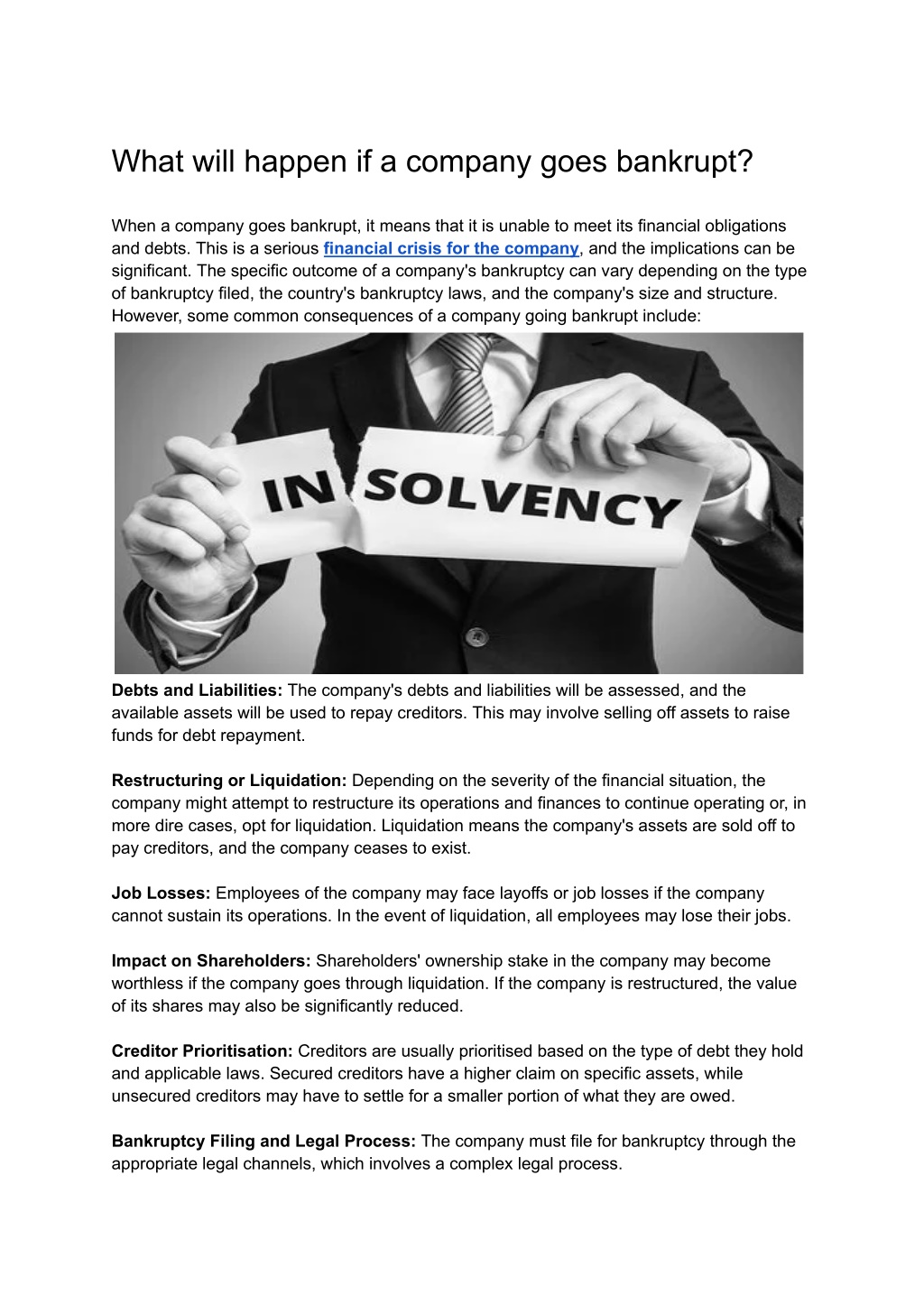Insights right into Company Administration: What Takes Place to Employees When a Company Goes into Liquidation?
Insights right into Company Administration: What Takes Place to Employees When a Company Goes into Liquidation?
Blog Article
The Process and Consequences of a Firm Getting Into Management
As a company encounters monetary distress, the decision to go into management marks an essential time that can have far-ranging ramifications for all entailed celebrations. The process of entering administration is detailed, including a series of steps that intend to browse the company towards potential recovery or, sometimes, liquidation. Understanding the roles and duties of a manager, the influence on different stakeholders, and the legal obligations that enter play is important in comprehending the gravity of this scenario. The effects of such a step ripple beyond the company itself, forming its future trajectory and influencing the broader business landscape.

Introduction of Company Administration Refine
In the realm of business restructuring, an essential preliminary action is acquiring a thorough understanding of the intricate business management process. Business management describes the formal insolvency treatment that intends to rescue an economically troubled firm or achieve a much better outcome for the firm's creditors than would be feasible in a liquidation circumstance. This process involves the visit of a manager, that takes control of the company from its directors to evaluate the economic scenario and determine the most effective strategy.
Throughout management, the firm is granted protection from legal action by its lenders, giving a halt duration to formulate a restructuring plan. The administrator deals with the business's administration, lenders, and various other stakeholders to create an approach that might entail marketing the organization as a going problem, getting to a firm volunteer setup (CVA) with financial institutions, or inevitably positioning the business into liquidation if rescue attempts show futile. The main objective of business administration is to optimize the go back to creditors while either returning the company to solvency or closing it down in an organized fashion.
Duties and Obligations of Administrator
Playing an essential role in overseeing the company's decision-making processes and financial events, the administrator assumes significant duties throughout the business restructuring process. The key task of the administrator is to act in the very best passions of the business's lenders, aiming to attain one of the most beneficial outcome feasible. into administration. This includes conducting a thorough analysis of the company's economic circumstance, creating a restructuring plan, and implementing methods to take full advantage of go back to lenders
In addition, the administrator is in charge of liaising with numerous stakeholders, including staff members, suppliers, and governing bodies, to ensure openness and conformity throughout the administration procedure. They must likewise connect efficiently with investors, providing routine updates on the firm's progress and seeking their input when needed.
In addition, the administrator plays a vital role in handling the daily procedures of the business, making crucial choices to maintain continuity and protect worth. This consists of evaluating the practicality of various restructuring alternatives, negotiating with lenders, and eventually leading the firm towards a successful exit from administration.
Influence On Firm Stakeholders
Assuming a vital setting in supervising the business's financial affairs and decision-making procedures, the manager's activities throughout the business restructuring process have a direct influence on numerous firm stakeholders. Investors may experience a decline in the worth of their financial investments as the business's financial difficulties are resolved. Financial institutions, including lending institutions and vendors, may face unpredictabilities relating to the repayment of financial debts owed to them. Employees frequently run into work instabilities as a result of potential discharges or adjustments in work conditions as part of the restructuring efforts. Clients may experience disturbances in solutions or product schedule throughout the administration process, influencing their depend on and commitment towards the firm. Furthermore, the community where the business operates might be impacted by possible job losses or adjustments in the company's procedures, influencing regional economies. Efficient communication from the administrator to stakeholders is crucial in handling expectations, reducing problems, and promoting openness throughout the administration process.
Lawful Effects and Obligations
During the procedure of business administration, mindful factor to consider of the legal implications and commitments is vital to make sure compliance and shield the rate of interests of all stakeholders involved. When a firm goes into administration, it causes a collection of lawful needs that need to be adhered to.
In addition, legal effects develop concerning the therapy of employees. The manager should adhere to employment regulations relating to redundancies, employee civil liberties, and obligations to give required details to worker reps. what does it mean to go into administration. Failure to adhere to these lawful requirements can cause legal activity against the firm or its administrators
In addition, the business entering management may have contractual commitments with various get redirected here celebrations, including vendors, customers, and landlords. These contracts need to be reviewed to determine the most effective strategy, whether to terminate, renegotiate, or satisfy them. Failure to manage these legal commitments appropriately can lead to disputes and potential legal consequences. In essence, understanding and meeting lawful responsibilities are critical facets of browsing a firm via the management procedure.
Approaches for Business Recovery or Liquidation
In taking into consideration the future instructions of a company in management, calculated planning for either recuperation or liquidation is important to chart a practical course ahead. When intending for business recovery, crucial techniques might include performing a detailed analysis of business procedures to identify inadequacies, renegotiating contracts or leases to improve capital, and carrying out cost-cutting measures to boost success. In addition, seeking new financial investment or financing alternatives, diversifying profits streams, and concentrating on core proficiencies can all i thought about this add to a successful healing plan.
On the other hand, in scenarios where business liquidation is regarded the most proper training course of action, methods would certainly involve maximizing the worth of properties through effective property sales, settling arrearages in a structured way, and following lawful requirements to make sure a smooth winding-up procedure. Interaction with stakeholders, consisting of consumers, staff members, and financial institutions, is essential in either situation to preserve transparency and manage expectations throughout the recovery or liquidation process. Ultimately, choosing the right strategy relies on a comprehensive analysis of the firm's financial wellness, market position, and long-term potential customers.
Conclusion
In conclusion, the procedure of a company entering management includes the visit of a manager, that handles the duties of taking care of the business's affairs. This process can have considerable repercussions for numerous stakeholders, consisting of investors, lenders, and employees. It is necessary for business to carefully consider their alternatives and techniques for either recovering from monetary difficulties or waging liquidation in order to reduce possible legal effects and responsibilities.
Company administration refers to the official insolvency treatment that aims to rescue an economically distressed business or attain a much better outcome for the company's financial institutions than would be possible in a discover this info here liquidation circumstance. The administrator functions with the company's administration, financial institutions, and other stakeholders to create a strategy that may entail selling the service as a going concern, reaching a business volunteer arrangement (CVA) with lenders, or inevitably placing the business right into liquidation if rescue efforts show useless. The key objective of company administration is to make the most of the return to lenders while either returning the firm to solvency or shutting it down in an orderly manner.

Report this page